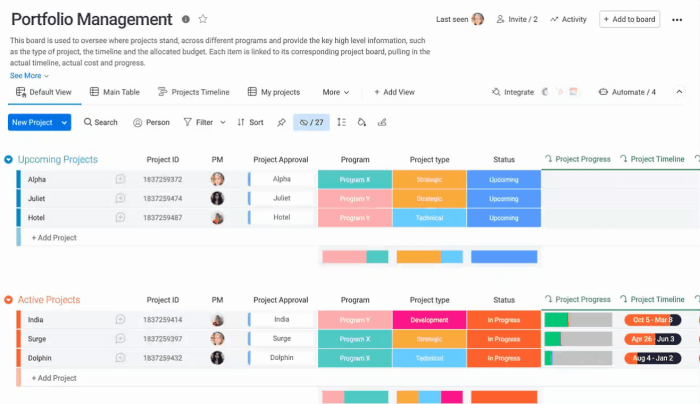Strategy is useless without implementation. Managing the transition between the two, adapting to changes, and executing effectively all depend on portfolio management.
Portfolio management is about selecting, managing, and executing projects on a grand scale. The right people and technology are the key to successfully establishing, managing, and executing your IT projects. Portfolio management gives you insight into these people, their projects, and associated costs.
At the end of the day, portfolio management means managing a group of tasks within a particular context. In this article, we’ll show you how to do this effectively.
What is covered in this article :
- What is portfolio management?
- There are 4 different types of portfolio management
- The key differences between portfolio management, project management, and program management
- Portfolio management best practices
- The challenges of portfolio management
- Why do you need a portfolio management platform?
- Why monday.com is the ideal portfolio management solution
- monday.com Project Portfolio Management Templates
- Final thoughts

What is portfolio management?
Portfolio management is a systematic process for selecting, evaluating, and prioritizing projects for investment. This centralized approach of prioritizing investments helps ensure that all investments are well-thought-out and that the organization’s overall objectives are being met. It also minimizes the risk of wasted projects.
In other words, project portfolio management is all about assigning responsibility. If you have large investments in projects, you want to make sure they’re being invested wisely and that you’re maximizing their potential. The right project portfolio management system will help you do just that.
When prioritizing projects, it’s important to align goals with strategies, values, and long-term goals. If your project is performing well, is aligned with your company’s overall strategy, and is aligned with the current strategy and direction of the organization, then it will likely stay funded. But if it’s risky or underperforming, then it may get specific funding priorities put on hold until more information is available. This is where portfolio management comes in place.
Portfolio Management is the ultimate driver of business performance. Whether you are trying to evaluate the financial health of your company or plan the future allocation of capital, a robust portfolio management system will provide you with the insights and analysis necessary to reduce risk and increase returns – now and in the future.
There are 4 different types of portfolio management:
- Active portfolio management
- Passive portfolio management
- Discretionary portfolio management
- Non-discretionary portfolio management
The key differences between portfolio management, project management, and program management
The relationship between portfolio, program, and project management can be described as it follows: Project management typically involves managing temporary or unique endeavors focused on a specific product or service. Program management involves several initiatives or projects that are related to each other, but not necessarily dependent on each other. Portfolio management is concerned with setting direction and providing oversight of multiple programs in order to align business objectives with IT initiatives in order to maintain a balance between cost, risk, and value.
A program is a collection of projects that have been grouped together for particular reasons. A portfolio is a collection of programs, each of which consists of individual projects.
Portfolio management best practices
There are a few key things to consider when choosing the best portfolio management software solutions. Additionally, factors such as time management and reporting should be taken into account. This is all in order to select a product that works best with your organization’s specific needs.
Detailed project inventory
Take stock of all your projects by adding a description that thoroughly covers the following: title, timeline, estimated costs, business objectives, potential ROI, and how it benefits the business.
The solution also allows you to create an instant high-level overview with all the information required to provide investors with updates or make better on-the-spot decisions.
With monday.com, you get a fully integrated portfolio management system that lets you seamlessly track dozens of investment accounts and thousands of holdings, along with portfolio rebalancing, wealth management analysis, tax reporting, and more. The best part? All the tools work together to make your life easier.
Strategic Evaluation
To determine which project deserves priority, we first consider how closely the project meets the company’s strategic goals. Other factors to consider are risk and disruption to productivity. If certain projects require massive reengineering of others, then those projects should be given higher priority.
Good portfolio managers will cut off any projects with poor business cases upfront, to ensure better alignment between management and stakeholders.
Prioritizing and funding projects
When making project decisions, it’s important to consider cash flow as a finite resource. Evaluating strategies based on strategy alignment and prioritizing projects based on available funding and resources will help you ensure that you are meeting your financial goals while remaining within budget.
When you have a large backlog of projects, you might be tempted to take any new project that comes in. Obviously, you’ll have to draw the line based on how many projects your budget and existing resources can support, but a scoring system can make that process much easier.
Reviewing and managing your portfolio
The first step in any project portfolio management process is to evaluate and prioritize initiatives. All too often, however, the focus of this work effort ends with the completion of a nice portfolio document that sits on a shelf collecting dust—or worse, it gets buried within an organization’s workflow in hopes that no one will need or reference it.
monday.com is designed to streamline the approval process, so everyone stays in the loop. By providing a clear visual of each project’s status, monday.com makes it easy for your team members to quickly understand the status of any project, even from a glance at a dashboard.
In order to ensure that the portfolio is performing well, portfolio managers should monitor their projects at least quarterly. To really excel in the field, this should happen more frequently than four times a year. Many portfolio managers request updates from their project managers monthly or bi-monthly. With those data points collected and entered into the project portfolio management system, it’s easy to track progress and assign statuses to each item.
With monday.com, the status color lets you see at a glance whether a project is on track or something needs to be re-prioritized. It can also alert you if a project is at risk of being delayed or becoming less efficient.
When it comes to the review process, portfolio review meetings are held throughout the year to consider how each initiative is progressing, and whether additional funding or other types of support like new personnel or partners are required. These meetings also help to evaluate whether it is worthwhile continuing with an initiative.
The challenges of portfolio management
Effective portfolio management is a highly effective strategy for delivering long-term value, but it requires considerable commitment from both the portfolio management team and stakeholders. Managing their engagement isn’t always smooth sailing. As both parties often have strong feelings about how decisions should be taken, conversations can run off track quickly if you’re not careful.
Research shows that groups make better decisions when they collaborate and build consensus. While it is easy to get derailed by the comment of one or two people, it’s important not to let them pull focus from the group. You will make better decisions under consensus than if one or two people are trying to make decisions for the rest of the group.
The data, models, and specifications of a project are all important. But they’re meaningless without a thorough understanding of how they work together to form the final product. To do this, you need good, reliable information on a consistent basis combined with dedication from the bottom to the top.
Another element to consider is the time constraint which is a critical element to consider when embarking on any project. In today’s world of fast-paced work where teams are often spread too thin, it becomes easy for a project manager and his or her team to get behind on projects because there is simply not enough time.
You will get a clear view of your team’s workload and time, so you can plan ahead more effectively. With the Workload View and Timeline View, monday.com makes it easy to see who’s overbooked and who may still have the capacity for a new project or task.
Why do you need a portfolio management platform?

As a project manager, it’s your job to keep track of activities and work-in-progress. You need to know where you’re at and what you still need to do to reach your goals but also the resources required to get there. If you aren’t equipped with a portfolio management platform, this can be difficult or outright impossible.
With one solution, you get greater transparency, up-to-date investment data, and real-time project statuses that are easy to track.
The best tool is one that also considers your project managers’ needs since their data needs to trickle up to higher-level portfolio managers and their corresponding boards and dashboards. A solution that eliminates manual data transfers or excessive status update meetings should be what you aim for, with the aim of improving your overall processes, and impact, and keeping your sanity.
At the same time, it’s important to remember that there’s no single “right” way to track your portfolio.
When you’re looking for a portfolio tracking system, you have a lot of choices. The right software has the flexibility you need to adapt to changing business needs, and can empower your organization to achieve more than it ever thought possible.
monday.com makes all of this possible.
Why monday.com is the ideal portfolio management solution

monday.com is a solution that allows you to build a custom portfolio management platform that will fit your needs better than any off-the-shelf “what you see is what you get” software. monday.com transforms how your organization thinks about and uses project management while lowering costs, reducing operating expenses, and raising productivity.
monday.com’s portfolio management tool is a robust and powerful solution that helps you get the most out of your projects. It offers an intuitive dashboard to visualize your strategic initiatives, allowing various stakeholders to collaborate in real time on large-scale tasks.
Moreover, with monday.com you can evaluate your company’s projects through a strategic lens to determine how best to proceed. Custom columns allow you to track funding rounds, funding status, resources invested, estimated current value, and last evaluation dates for each project, so you always have all the information at your fingertips.
You can prioritize, categorize, and fund projects based on custom columns that show priority and custom project scoring. Use the drag-and-drop feature to update your project list with new tasks.
You will be able to thoroughly review and manage your portfolio with custom dashboards that provide a snapshot of the overall profitability and health of the portfolio. With an intuitive interface that is easy to use, you can filter by customer, product, or customer segment, so you can quickly find what you need.
monday.com’s unique task ownership feature makes it easy to assign individual tasks to different people based on their skill sets and availability. This can help improve performance, and quickly identify potential risks that may arise.
monday.com Project Portfolio Management Templates
monday.com lets you create a project portfolio management template from scratch, or choose from several ready-to-use templates in the monday.com library. Once formatted, execute the plan by assigning team members to be responsible for each action item, and keep tabs on their progress with regular reporting and updates.
monday.com offers a visual, highly customizable workboard where you can track all activities of your projects. It adapts to fit any industry and role with an array of board templates that includes Gantt charts for project planning, calendars for events and tasks, kanban boards for workflow management, and task boards for project management.
Final thoughts
If you are looking for a portfolio management tool that delivers results for you and your team, you don’t need to look any further. monday.com helps leaders at all levels of an organization get things done through tailored work management, project collaboration, and planning tools. monday.com enables projects to be more efficient, organized, and collaborative than ever before.
As we mentioned throughout this guide, monday.com is a unified digital workplace that offers both office and project management tools. Users are able to collaborate, create tasks and milestones, and gain visibility throughout their teams by sharing updates in real time. With next-level customization of 30+ column types, unlimited automation capabilities, and dozens of integrations, users can curate their ideal digital workflows, integrate with their existing tools, and connect the dots across their organization.
With monday.com, your portfolio will always be up to date from one central place. You can jump right into managing your properties or tenants with our Portfolio Management Template or start from scratch by importing data directly into monday.com for a customized solution that works for you.
monday.com is the most intuitive, powerful, and secure solution for managing your work portfolio. It can help boost efficiency in all areas of your business and make your team more productive. The simple interface of monday.com makes it easy to use, while the advanced options give you room to grow as your business grows.
Recommended Reads:



